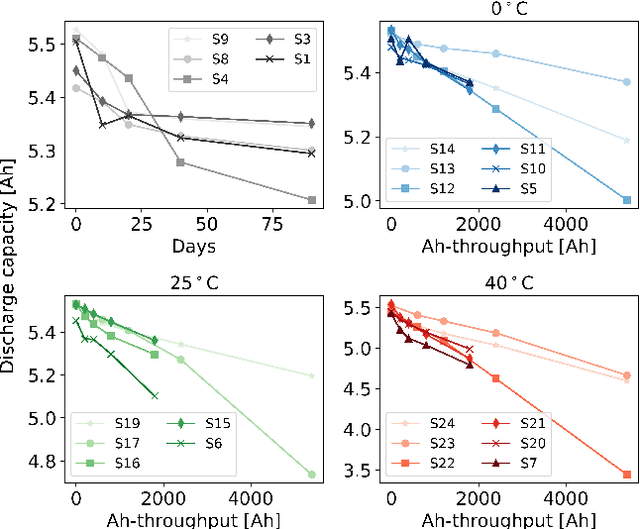Muhammad Aadil Khan
Onboard Health Estimation using Distribution of Relaxation Times for Lithium-ion Batteries
Oct 20, 2024



Abstract:Real-life batteries tend to experience a range of operating conditions, and undergo degradation due to a combination of both calendar and cycling aging. Onboard health estimation models typically use cycling aging data only, and account for at most one operating condition e.g., temperature, which can limit the accuracy of the models for state-of-health (SOH) estimation. In this paper, we utilize electrochemical impedance spectroscopy (EIS) data from 5 calendar-aged and 17 cycling-aged cells to perform SOH estimation under various operating conditions. The EIS curves are deconvoluted using the distribution of relaxation times (DRT) technique to map them onto a function $\textbf{g}$ which consists of distinct timescales representing different resistances inside the cell. These DRT curves, $\textbf{g}$, are then used as inputs to a long short-term memory (LSTM)-based neural network model for SOH estimation. We validate the model performance by testing it on ten different test sets, and achieve an average RMSPE of 1.69% across these sets.
Taking Second-life Batteries from Exhausted to Empowered using Experiments, Data Analysis, and Health Estimation
Feb 29, 2024Abstract:The reuse of retired electric vehicle (EV) batteries in electric grid energy storage emerges as a promising strategy to address environmental concerns and boost economic value. This study concentrates on devising health monitoring algorithms for retired batteries (BMS$_2$) deployed in grid storage applications. Over 15 months of testing, we compile, analyze, and publicly share a dataset of second-life (SL) batteries, implementing a cycling protocol simulating grid energy storage load profiles within a 3 V-4 V voltage window. Four machine learning-based health estimation models, relying on BMS$_2$ features and initial capacity, are developed and compared, with the selected model achieving a Mean Absolute Percentage Error (MAPE) below 2.3% on test data. Additionally, an adaptive online health estimation algorithm is proposed by integrating a clustering-based method, limiting estimation errors during online deployment. These results constitute an initial proof of concept, showcasing the feasibility of repurposing retired batteries for second-life applications. Based on obtained data and representative power demand, these SL batteries exhibit the potential, under specific conditions, for over a decade of grid energy storage use.
 Add to Chrome
Add to Chrome Add to Firefox
Add to Firefox Add to Edge
Add to Edge